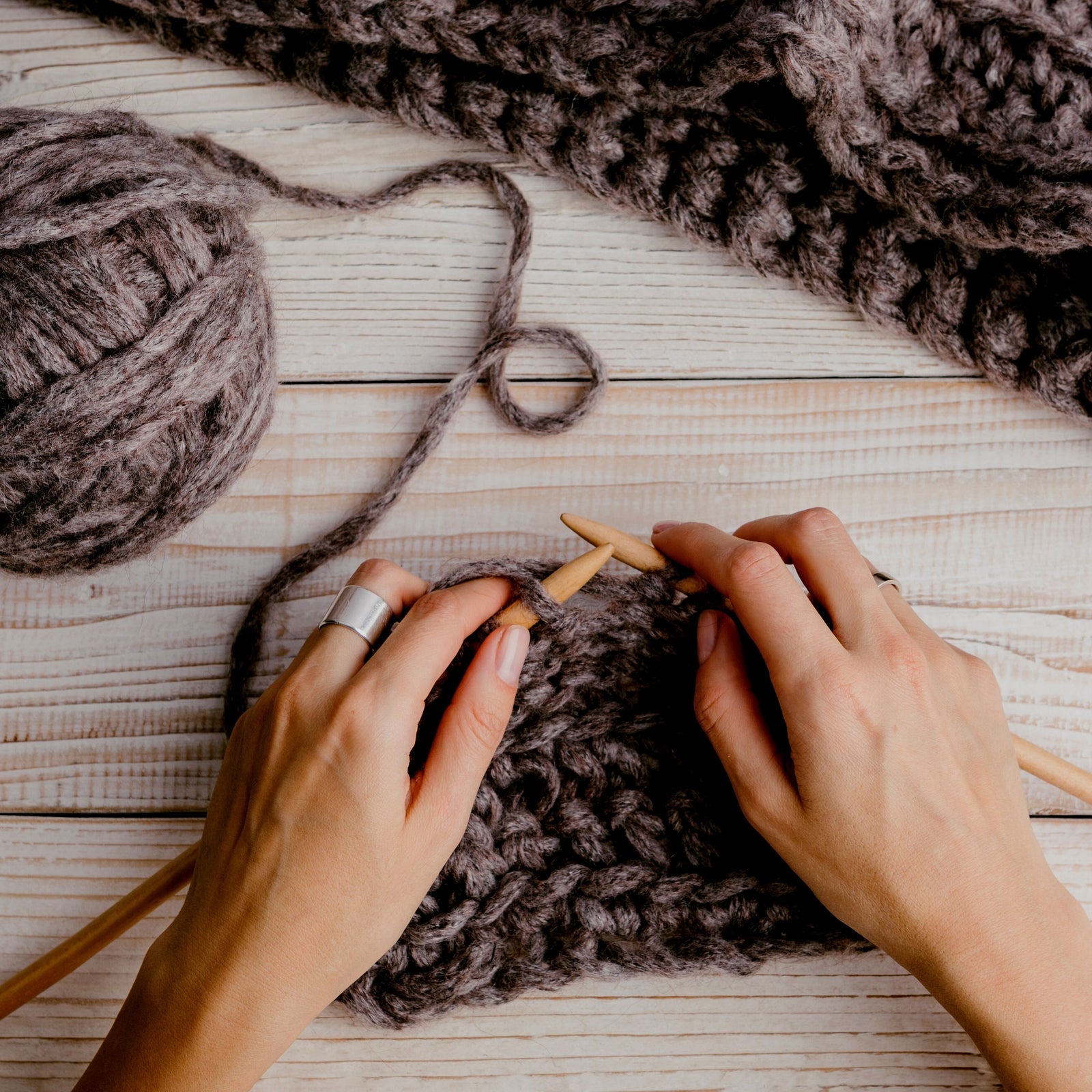Let me tell you a secret about weavers: we are all knitters. Or at least former knitters, for the most part. Weaving is usually at least someone’s second or third fibre craft. Scratch a weaver, and you will find a knitter, embroiderer, crocheter, or spinner. If you’re a knitter who is curious about weaving, here’s some information to help welcome you into the weaving world.
What is weaving?
Did you do that craft in kindergarten where you took strips of construction paper and went over-under-over-under another set of strips to make something that looked like a basket? That’s the basic idea of weaving a simple structure called plain weave. Except that we use looms to lift up every other strand of yarn at the same time, so that instead of having to go over-under-over-under each one, we can just pass the width-wise yarn (called the weft) straight across, and do a whole line at once.
In basic knitting, you take a single strand of yarn and transform it into a project by twisting and looping it into different stitches. Basic weaving uses two sets of yarn--the warp and the weft--that intersect with each other at right angles. The warp threads run the length of your project. Your loom puts tension on the warp to hold them tight. Then your loom lifts some warp threads to make an opening, and you pass the weft through that opening. The weft goes back and forth across the width of your project. Depending on which warp threads your loom lifts, and in what order, you can make all sorts of different patterns: diagonals, zig zags, diamonds, floral patterns, geometric shapes... the sky is the limit!
On a single set of warp threads, you can make one project, or two projects, or twenty. It all depends on how long your warp is, what kind of loom you’re using, and your patience.
How does weaving compare with knitting?
Weaving is generally much faster than knitting, because the loom manipulates several threads at a time. On a rigid heddle loom, a reasonably experienced weaver can make a scarf from beginning to end in a few hours. Setting up a floor loom takes a lot longer--it can take several hours to get your warp ready to weave on--but once you’re up and running you can weave a meter of intricate, beautiful cloth as wide as your loom in an hour or two. If you make several projects on the same warp, your time per piece is still just a handful of hours.
Weaving makes efficient use of yarn. Compared to knitting or crocheting, it uses less yarn per square inch of cloth produced. That said, there is always a section of warp that can’t be woven on any given project. This is called “loom waste”, and can be anywhere from five to 30 inches depending on your loom. Getting used to cutting off yarn and throwing it away (or finding a creative use for it) is often a big adjustment for knitters!
Weaving obviously takes up more space in your home than knitting, especially on a large floor loom which can be about the size of a piano! Not something you can fit in a project bag. If space is a concern, table looms and rigid heddle looms are good options. Weaving also requires an initial investment in a loom, which can be a bit of a leap of faith to take. I like to think of it as being like buying a guitar or a set of art supplies… the cost seems more reasonable when you think of all of the enjoyment you will get out of it.
Both weaving and knitting give you the ability to play with colour and pattern, but knitting gives you many more options for the shape of your finished piece. Knitting can give you toques, sweaters, and intricate shawl shapes. Weaving produces rectangular cloth. It may have incredible complexity within that shape, but the overall shape remains the same. That said, there’s nothing saying your weaving has to stay a rectangle forever! We love transforming handwoven cloth into all sorts of projects with a sewing machine.
What’s the best loom for me to start on? What is a knitter’s loom?
There is no single right answer here (see our post on Choosing Your First Loom for all the details!). If you have space, time, and ambition, you may want to jump straight into a multi-shaft floor loom. But if you’re looking for a loom that will let you get started quickly and help you use up your knitting stash, rigid heddle looms make great first looms. They range from 16-30 inches wide, and can make scarves, tea towels, and more!
Rigid heddle looms are sometimes marketed as “Knitter’s Looms”, but there is no functional difference between a so-called “Knitter’s Loom” and a Rigid Heddle Loom. It’s just a marketing term. Just to be clear, though, we aren’t talking about the circular plastic ‘hat looms’ you’ll find at big box craft stores. These are fun tools for making tubular hats and socks, but they aren’t weaving looms. Rigid heddle looms are sometimes called “Knitter’s Looms” because knitters love them! They are designed to make quick, small projects using the same sizes of yarn most popular with knitters (anywhere from Bulky to Lace Weight). They also create less loom waste, so you can make a warp with a precious skein of hand-dyed yarn without wasting it (or at least without wasting too much).
What’s the difference between knitting and weaving yarn? Can I weave with my knitting yarn?
To a large extent, the difference between weaving yarn and knitting yarn is just marketing and packaging. Because weavers often use more yarn in a single project than knitters do, weaving yarn is normally packaged on cones rather than in skeins or balls. Cones are easier to place on the floor and draw yarn off of to wind a warp or a bobbin. And since weavers aren’t carrying around their work in project bags, we aren’t bothered by the bulkiness of the cones.
There are also some fibres (like cotton and linen) and some sizes of yarn (different degrees of ultra-fine yarn) that are more popular with weavers than with knitters, and that get marketed as weaving yarn as a result. But at the end of the day, yarn is yarn. You can weave with knitting yarn and knit with weaving yarn.
So yes, you can absolutely weave up your stash of knitting yarn! In fact, many knitters take up weaving as a stash-busting hobby, since weaving goes through yarn so much faster than knitting does. We stock yarn from local producers who are well loved in the knitting world, like Luddite Yarn and Ancient Arts Yarn.
A few caveats: the yarn that gets used as warp (the threads that run for the whole length of your project) gets put under a lot more tension in weaving, so you can’t use most single-ply yarn or other weak yarns for warp. You can, however, use singles and pretty much anything else you want as the weft (the yarn that you pass back and forth across the warp). You’ll also find that many weavers avoid superwash wool. In knitting, your yarn gets twisted into loops that give your piece volume and squishiness. In weaving, oftentimes your end project is much more two-dimensional. Weavers count on “fulling” or “wet finishing” to give their project a little more body. This is washing the project so that the threads bloom or even slightly felt in a controlled way. You can’t felt superwash, so it won’t full. You can absolutely weave with it, but just know that it will behave differently.
How do knitting yarn sizes translate into other sizing systems?
If you start surfing around Gather’s yarn options, you’ll see that weavers speak a different language. There are funny numbers like 8/4 and 16/2 for cotton and linen, and yarn is being described as having a certain number of ypp (yards per pound) or epi (ends per inch).
Ends per inch is probably the most useful term to wrap your head around. It refers to the number of strands (or ends) of yarn that go into one inch of warp. It only takes a few strands of bulky yarn to fill up an inch on a loom, so they have a low epi. But you might be able to fit several strands of worsted weight yarn, or dozens of strands of lace weight yarn into the same space! The finer the yarn, the higher the epi.
Here are the rough equivalents of standard knitting yarn sizes in epi:
Super Bulky Yarn = 2.5 epi
Bulky Yarn = 5 epi
Worsted Weight Yarn = 8 epi
Sport Weight and Double Knit Yarn = 10 epi
Fingering Weight Yarn = 12 epi
Lace Weight Yarn = 15+ epi
Cotton has its own sizing system in the weaving world. Each size consists of two numbers: the first is the size of each ply of yarn, and the second is the number of plies. So 8/2 cotton has two strands of size 8 cotton. That means 8/4 is twice as thick (because it has twice as many plies) and 8/8 is even thicker. In knitting terms, 8/8 is worsted weight, 8/4 is sport or fingering weight, and 8/2 is lace weight.
You’ll find that fine weaving yarn goes much smaller than the finest yarn you would want to knit with. It’s fairly common to see weaving projects using yarn at 18, 20, or even 30 ends per inch! Fine projects take longer, but they can create incredibly delicate cloth. Don’t worry though--most of our beginner patterns range from 10-18 ends per inch.
How can I get started?
Taking a weaving workshop is a great way to get a sense of whether you will love weaving. Many weavers will tell you they fell in love the first time they got hands-on experience on a loom. If you’d like to try one out at home, check in with us about renting a rigid heddle or table loom.
If you already have access to a loom, our free patterns and online education offerings can help get you up and weaving. And of course we’d love to see you in store and talk through which materials would help you turn your ideas into cloth!

